Work in progress: We have learned new details, regarding house at 535 Lake Promenade in Long Branch, battered off its foundations by enormous storms on Lake Ontario on March 13, 1952 – Part 1.0
A recent post is entitled:
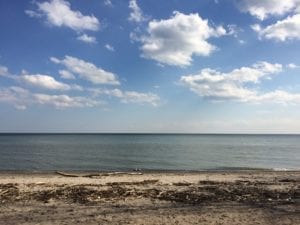
Beach at Marie Curtis Park in Long Branch. The view is from a location west of corner of Lake Promenade and Forty Second Street. Jaan Pill photo.
At the above-noted post, I have shared a newspaper article sent by Liesa de Groot whose mother, Ursula Kubart, three years old at the time, was the youngest member of a family newly arrived in Canada, whose home and possessions were wiped away in storms on Lake Ontario on the night of March 13, 1952.
Liesa de Groot wishes to learn more details about 535 Lake Promenade including stories related to the family and community that lived at the mouth of Etobicoke Creek at that time. The previous post served to set the scene for this quest.
Liesa’s message has, for me, brought the events of March 13, 1952 to life.
In a subsequent message on Sept. 10, 2019 Liesa has commented further:
Its possible someone may remember a family of German immigrants (the younger children spoke no english) or possibly because it was the storm preceding Hazel the house may have stood out more than the amount of damage Hazel brought. My mother says they lost the house, there was nothing left and they salvaged no possessions as they had no where to go. They stayed at the salvation army for quite some time until they got back on their feet. She says all she heard was the land was never allowed to be built on again so I would have to assume it was expropriated. There was a mortgage on it so it may have been through the lender/city if that were the case. Land registry should be able to clarify that so I may have to go down there rather than attempting the computer with an address that no longer exists.
There isnt much else to do but start somewhere and see where it takes you.
Thank you again Jaan, I really do appreciate your assistance and with any luck maybe we can find a small piece of some lost history.
Warmest thanks
[End]

Caption of photo scanned by Liesa de Groot: Recent arrivals from Germany, the Kubart family lost furnishings in back bedroom of frame house which was swept away by waves at 535 Lake Promenade, Long Branch. With Mr. and Mrs. Kubart are their children (in front) Annelie, 5; Ursula, 3; Arno, 7; (at back) Wolfgang, 14; Ingrid, 16.
At the current post – which is a work in progress as I am taking a break to assist with a consulting project – I will share part of what I have learned, in response to Liesa’s questions about a lost story from the past.
At subsequent posts I will share information from Bob Lansdale and Robert Lansdale, whose family had a cottage on the Lake Ontario shoreline near 535 Lake Promenade.
Liesa de Groot has sent me two attached files:
Newspaper article, sent by Liesa de Groot
Photo from article, sent by Liesa de Groot
The above-noted photo (see link above) has the appearance of the use of flash photography. I believe the flash effect is from the fact that flash was used in taking a photo of the photo; I note the same flash effect is evident in the image of the newspaper article, in the link (see the other link above the current paragraph) entitled “Newspaper article, sent by Liesa de Groot.”
The text of the article that Liesa has shared appeared on page 15 of the March 24, 1952 Globe and Mail.
However, the version Liesa has attached does not have the name of the author like the article in the Globe and Mail, which raises the possibility the article from Liesa is from a version subsequently republished in the Advertiser.
Microfilm for the Advertiser is available at the Toronto Reference Library in the basement newspaper room.
Information from archives
Part 1 – March 14 and March 24, 1952 Globe and Mail; March 24, 1952 Toronto Star
In our efforts to answer Liesa de Groot’s quest for information, we owe thanks to area residents who are skilled in archival research. From such research, we have a better idea of the context, within which the Kubart family lost their house and belongings.
Key links, to relevant archival newspaper files featured below, have been forwarded to me by an archival researcher.
I have also included links I found on my own at the Toronto Public Library website.
A number of severe storms, which occurred on Lake Ontario and elsewhere in March 1952, are described in newspaper reports published 0n March 14 and March 24, 1952.
At this post I will share content of some of the news reports.
The storm that affected the Hobart family occurred on the night of March 13. Photos of the family appear in both the March 14 and March 24 newspaper accounts, and an article describing the family’s loss of home and belongings was published in the Globe and Mail on March 24, 1952.
We start with relevant pages from the March 14, 1952 Globe and Mail:
March 14, 1952 Globe and Mail, page 1
March 14, 1952 Globe and Mail, page 1
March 14, 1952 Globe and Mail, page 2
March 24, 1952 Globe and Mail page 2
March 14, 1952 Globe and Mail, page 3
March 14, 1952 Globe and Mail, page 3
The photos at above-noted third page includes one of the Hobart family, which is the same photo, accompanied by same caption, as is featured at the top of the current post.
School closed on Toronto Island
A caption for an additional photo, from Toronto Island, reads: “Sixty children were sent home from Ward’s Island [on Toronto Island] when bus drivers told the teacher they couldn’t guarantee safe passage.”
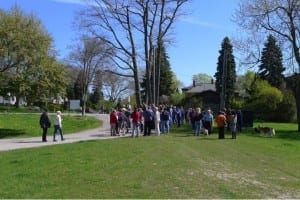
Long Branch Jane’s Walk, May 6, 2012, began at mouth of Etobicoke Creek. The photo shows southeast corner of Marie Curtis Park. In years past Lake Promenade extended far to the west, past the point where the roadway currently terminates at Forty Second Street (on left in photo). Peter Foley photo
Waves break down retaining wall
A caption for another photo reads: “Pounding waves of an easterly storm have broken down retaining wall (foreground) and are now undermining frame houses along Lake Promenade at Long Branch. Above-normal level of lake has contributed to destruction. Six families have been taken to Red Cross shelters.”
March 24, 1952 Globe and Mail, page 15
At a previous post, I’ve shared the following text, from a March 24, 1952 Globe and Mail article by James Hornick, which reads as follows below – but please note, I have modified the quotations so they are presented in plain English.
You can read the original version of the article here:
March 24, 1952 Globe and Mail, page 15
In the original text, the new Canadians are quoted in a way that seeks to convey their German accents. In this particular circumstance, I find such an approach to reporting irksome, for which reason I have opted for a plain English version.
I have also written the title in sentence case as it’s easier to read than when all words (articles such as a, the, and of excepted) are capitalized.
The reporter implies the husband made the decision to bring his family to Canada. It’s possible, however, I would note, that it was a joint decision also involving the wife and possibly other members of the family.
If you wish to read the original version, please refer to the link above.
The article was prepared between March 14, 1952, the day after the extreme storm events, and the publication date of March 24, 1952. The author had time to write an in-depth article.
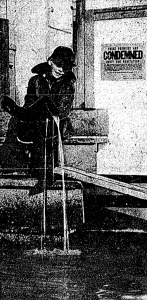
March 24, 1952 Toronto Star, page 1. Caption reads: LAKE PROMENADE home of George Dick, 9, was condemned as a result of Saturday night storms which swept along a 300-mile stretch of Lake Erie, Lake Ontario shores. Collective photo credit on page: Star Photos by Alex Grey and Frank Teskey
My modified version of the text reads:
Homes wrecked, beaches devastated by storm, stormy lake destroys home of immigrants
Globe and Mail, March 24, 1952
By James Hornick
A thoroughly exhausted family of seven sat in bewildered silence yesterday afternoon while a Sunday school class sang three lusty choruses of Yes, Jesus Loves Me. Heinrich Kubart, his wife and five children were completely oblivious to the joyous discord. They were so close to nervous collapse that none could sit at ease. Conversation seemed pointless and painful.
There was a time, just a few months ago, when the Kubarts could relax and laugh. Yesterday, in the austere Salvation Army citadel at Long Branch, happiness was a memory. In one shattering blow all their new-found possessions, a home, furniture and clothing, had been wiped out.
Heinrich Kubart is a 45-year-old German immigrant of medium build, long jaw and quiet manner. He came to Canada eight months ago from Arnsberg, in the Dortmund region of West Germany. He brought with him his wife, daughters Ingrid, 16; Annelie, 5; and Ursula, 3, and sons Wolfgang, 14, and Arno, 7.
When the Kubarts disembarked at Halifax they possessed $500 and a fleeting acquaintance with the English language. In Arnsberg, Heinrich Kubart had been employed in a factory manufacturing synthetic rubber. In Canada, his English would have to improve before he could claim a good-paying job. “We come to Toronto,” he said. “We have no friends but we hear about Toronto. We have little bit money and we get along.”
Heinrich obtained employment as an orderly at the Ontario Hospital on Queen St. His family moved into a few bare rooms. They stretched their budget and counted the coppers until they had scraped together $800.
“We find house in Long Branch,” said Mrs. Kubart. “Five rooms cottage. Little bit close to lake, but it is house of our own.”
The Kubarts moved in on Nov. 15. They paid $64 a month, $50 to reduce the mortgage and the balance in interest and taxes. Their home was at at the 535 Lake Promenade.
“Nice place,” put in 16-year-old Ingrid. “We have our own house already.”
But on March 13, misfortune called at the back door. During one of Lake Ontario’s periodic storms, waves broke heavily against the back wall. An entire bedroom was wrenched loose from the building and swept into the lake.
We lose bedroom suite,” said Mrs. Kubart. “But nobody hurt. We happy.”
Most of the debris had been cleared when, at midnight, another storm visited the ill-fated home of the Heinrich Kubarts.
“We was asleep,” Kubart said. “About midnight the windows cracked. Glass all around. The roof cracked. Then the walls. All around is water. Maybe 10 inches. The wind make bad noise. The house shake.”
Kubart rallied the family, attempted to soothe the crying children and herded them toward the back door. By this time, pebbles, rocks and boulders were showering through the gaping hole in the back wall.
“We run to kitchen,” said Ingrid. “Whole house rocking.”
The father led his wife and children through ankle-deep water up Lake Promenade. The fury of the storm was increasing. Their house was by now battered off its foundation. Clothing and furniture were buried in debris and soaked with spray.
“We try and get hotel room,” Kubart said. “All full up. We call police. We call fire house. We have no friends. Then some people take us here. We sleep on floor and chairs. People are good.”
The Salvation Army provided makeshift accommodation for the first night. All day Heinrich Kubart, his wife and five children huddled in the assembly hall, their reverie broken only by the occasional appearance of a Salvationist with fruit and candy, and by the next chorus of Yes, Jesus Loves Me.
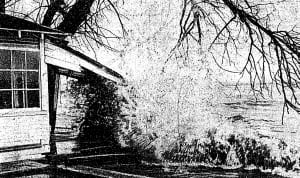
March 24, 1952 Toronto Star, page 1. Caption reads: LAKESIDE HOUSE IN MIMICO is pounded by waves which have already crumbled the veranda. Cottage was occupied by Mr. and Mrs. Tom Warrington, Jamdes Boyd and Frank Beadmore, all of whom recently arrived from England. Much of their clothing and furniture was swept out into the lake. “Even blitz was nothing like this,” said Warringtons. Collective photo credit on page: Star Photos by Alex Grey and Frank Teskey
March 24, 1952 Toronto Star, page 1
March 24, 2019 Toronto Star, page 1
In future, if I get around to it, I will post all of the photos, from the newspaper pages featured at the post you are now reading.
The current post includes a front-page photo from the March 24, 1952 Toronto Star that features a boy emptying water from a rubber boot while he stands in front of his storm-battered house in Long Branch. The photo displays a sign affixed to the house, which reads, “These premises are CONDEMNED.”
Buttonville: 36 consecutive poles town down by winds
Another photo (which I have not uploaded to the current post) features extensive retouching, so that the forms are clearly outlined. The caption reads: “ON DON MILLS Road, near Buttonville, a lineman checks wires attached to one of 36 consecutive poles which were pulled down by winds which reached velocity of 60 miles-per-hour. The storm penetrate 50 miles inland, caused two deaths, flooded town.”
Photo retouching in 1950s newspapers is up-front and obvious; the result is a retro look, which brings to mind the image manipulation that underpins Andy Warhol’s early work, and is also characteristic of the wider Pop Art movement that emerged during the 1950s.
In turn, the simplification of imagery (and accompanying reframing) that characterizes Pop Art is also evident in work by street artists such as Banksy. Such simplification also characterizes much of propaganda art promoting a wide range of ideologies.

Walking west along the Waterfront Trail during May 6, 2012 Jane’s Walk in Long Branch. Walkers are heading toward Applewood Creek in Mississauga. Trail that you see is where the southern branch of Etobicoke Creek used to flow – parallel to the trail, and south of it – on its way to Lake Ontario during Country Cottage era. Lake Promenade ran parallel to trail – close to shoreline visible on left. Mike Foley photo
Trees uprooted on Lake Promenade
Another photo, at a page included in links at the current post, features a man leaning against two large uprooted trees in what is now Marie Curtis Park. The caption reads: “TREES WERE UPROOTED at Lake Promenade, in Long Branch.”
Winston Churchill
The front page of the March 24, 1952 Toronto Star includes a brief news item referring to the British prime minister of the day, Winston Churchill. There is also a reference elsewhere, in one of the pages for which I have provided links, to the Canadian prime minister of the day, Louis St. Laurent. The Ontario premier at the time was Leslie Frost.
21 Long Branch homes reduced to rubble
A March 24, 2019 Toronto Star headline, headline at the bottom of page 1 (which is in all capitals in the original; I have converted the text to sentence case, for ease of online reading) reads:
“Furious waves devour 21 Long Branch homes, [officials] demand provincial aid.”
I’ve added the word “officials” as otherwise the headline doesn’t work. I assume there was not enough space to squeeze in all the words. This would likely occur from time to time, when people are busy working toward a deadline, for getting the next edition of a paper printed.
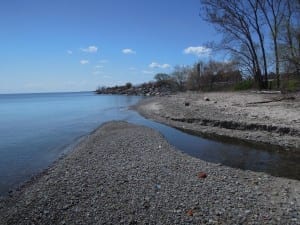
Applewood Creek at Mississauga-Toronto border at Lake Ontario shoreline. The border, as confirmed from an online Gosur.com map of Ontario, is located to the west of the creek. Previously, I had the impression that the border was to the east of Applewood Creek. Jaan Pill photo
Like other articles at the page, this report follows a standard inverted-pyramid format, in which the first few paragraphs present key points (the five Ws – who, what, where, when, why); the rest of the article adds details. In this way an editor can cut a story at any point, in order to fit the words into available space while keeping the story intact.
The article reads (starting page 1 and continuing page 3):
Furious waves devour 21 Long Branch homes, [officials] demand provincial aid
By Bruce MacDonald
Star Staff Correspondent
Long Branch, March 24 [1952] – In the wake of a 60-mile-an hour [97 kilometres-an-hour] week-end gale that turned into a pounding monster which reduced 21 Long Branch homes to rubble and drove more than 40 families into the rain-swept darkness, Reeve Thomas F. Carter today made an urgent appeal ro the provincial government for immediate emergency relief.
“Some people have lost everything, everything they had in the world, except the clothes on their backs,” he declared. “The situation is identical to that of the Winnipeg flood, only on a smaller scale. The people must be rehabilitated. The job is more than we can do alone. The government must help.”
After a personal inspection of dwellings along Lake Promenade drive, stretching for half a mile, members of the village council condemned 21 homes as unfit for habitation. Many people lost their life savings in the homes that will be razed.
“We must have help; we cannot carry the load of assisting these people without aid from the outside,” the reeve said after he had seen the full extent of the damage. He would seek an immediate conference with Premier Frost or members of his cabinet to discuss the problem, he said.
For years the village has urged the provincial government to share the cost of a $700,000, mile-long breakwater to protect the lakeshore homes. Now, supported by the mute testimony of shattered houses and homeless families, the reeve said he would again place the council’s case before the government in hope that other homes may be saved from other storms.
“The blueprints are already prepared. But the cost is so high that a municipality the size of ours cannot possibly afford to pay it all,” he asserted. The government has considered introducing legislation which would permit it to provide aid but to date has given no assurance that it will.
GLAD TO ESCAPE WITH LIVES
Late Saturday night an east wind began to blow. It whipped Lake Ontario into a frenzy. And the darker it got, the harder the wind blew, and the higher the waves became. In the worst storm in the memory of residents, the hungry waves tore at waterfront homes in Long Branch, Mimico and New Toronto, heaving, twisting, battering them with stones, logs, wreckage, until the owners fled, thankful to escape with their lives.
All night the waves battered houses along Lake Promenade in Long Branch. The wind fell somewhat at daybreak, but later awoke with aroused fury, and continued its work of destruction. One house in New Toronto, at the foot of Fourth St., disappeared completely, and several houses in Long Branch broke out bit by bit and were swallowed by the lake.
RISK LIVES IN SALVAGE WORK
“Village officials, works department employees, and innumerable volunteers risked their lives to move furniture from the homes, many of them surrounded by a foot of rising water at the height of the storm. As Reeve Carter and others worked in one house to salvage as much as possible, a wall washed in, soaking everyone to the skin. [Unclear what a “wall washed in” means, but one gets the gist.]
HOUSE SPLIT IN TWO
“Sunday morning, after spending a night of terror, Mrs. George Billyk bade farewell to her home with tears in her eyes. Even as town workmen moved out the furniture belonging to her family, the house split in two. Mr. and Mrs. Billyk and their four children were without a home.
It took Fred Anderson 20 minutes to get the door of his home open to let his wife and family of seven small children out when the waves knocked their home off its foundations. His wife suffered two badly injured knees, and Pamela, two, received bruised shoulders and a cut when they were knocked out of bed. Clad only in such clothing as their parents could scratch up, Bobby, 10, Barbara and Beverley, eight-year-old twins, Joanne, seven, Heather, four, Pamela and Vicky, six months, were rushed to neighbors on higher ground. [Pamela’s age isn’t mentioned as it was mentioned earlier in the paragraph.]
Their trim little bungalow, which they had contracted to move back from the lake, is tilted into the water, holes in the floor where the posts on which it rested has gone through. After town workers had worked against time to move their furniture before the waves washed it out into the lake, a big wave picked it up, tilted over the stove, and set fire to the house. Mr. Anderson, neighbors and volunteers put it out with lake water.
“You work so hard, and try to get ahead, and then this has to happen, said Mrs. Anderson, fighting back sobs. “We had paid to have the house moved back, and the man didn’t come. We even had the services disconnected so it could be moved. If he’s only come, we wouldn’t be in this mess now.”
Town workmen backed up a large truck to his home, and town officials and workmen, assisted by volunteers, managed to salvage the household effects. Another large truck backed up to the home of Thomas Spriggs next door, and Spriggs and his three sons helped to carry out their belongings. Friends said Mr. Spriggs has spent thousands of dollars refurbishing his home. It, too, was to have been moved back from the lake.
Some of those who surveyed the small pile of household effects they were able to pull from the clutches of the grasping waves or the red “Condemned” sign that seemed to mock them from the shattered walls of the place they once called home, were overcome with bitterness and recriminations.
Robert MacLean, father of two children, felt the same way. “I sank all of the money I had into this place. Now what am I going to do?” he asked as he thought of the red sign that hung outside his door.
“The township has taken the easy way out. If they would show some action instead of cheap talk, we would be better off,” he continued. “They have talked endlessly about a breakwater, but they have done nothing about it.” He went down and picked two water-logged pillows off the floor. “Might salvage these,” he said to his son, John, 14.
“Well,” he continued, tucking the pillows under his arm, “we can afford to send all that charity to foreign countries. Let’s see if there is any for those of us who need it at home.”
As far as the reeve and councillors were concerned, destruction of some of those houses was the only feasible policy. “Some are so hopelessly damaged they can never be repaired,” Mr. Carter said. “Some we don’t want repaired because another storm will just damage them again and the whole situation will be repeated,” he said.
A steady stream of cars was turned back as sightseers sought to get a glimpse of the ruined homes. Reeve Carter and other members of council took time out only to go home for dry clothes and went back again to help. Men moved furniture. Deputy-reeve Marie Curtis carried young children to safety.
“It was wicked,” said Mr. Carter. “It was freezing, sleeting, and blowing like the dickens.” First call came at the 3.10 a.m. to the police office that part of a house had collapsed. At 4 a.m. Mrs. Anderson called that her home had been knocked from its fountains and their seven children taken out. A few minutes later came a call that the home of Thomas Spriggs was trembling. At 4.35 a.m. Mrs. Robert MacLean called and asked that the family furniture be taken out.
Another Toronto Star report also highlights storms of March 1952
Another article reads:
2 killed on icy roads, 500 flee homes, storm hits Lake Erie, Ontario
Storms that swept along a 300-mile stretch of Lake Erie and Lake Ontario shorelines and penetrated is 50 miles inland, caused two deaths Saturday night [March 22, 1952], flooded towns and villages and cut transportation, hydro and telephone services in dozens of localities.
Homes, rich farmlands and public utilities suffered extensive damage from Windsor to 50 miles east of Toronto in one of the worst wind and rain storms in decades to hit southern Ontario.

Map of previous Cottage Era configuration of Etobicoke Creek. Map also shows location off former Pleasant Valley Mobile Home Park (PVMHP) in Mississauga (formerly known as Toronto Township). Source: Jaan Pill, March 2019
ICE COATS HIGHWAYS
Highways coated with ice after the rain Saturday night are blamed for two Ontario deaths.
Mrs. G. W. McNabb, 53, of Owen Sound, was killed instantly when the car she was riding in went out of control on No. 26 highway, for 15 miles northwest of Barrie. The car slammed broadside into a telephone pole, them plowed through a ditch and struck a second pole before stopping.
Injured in the crash were Mr. and Mrs. John Walsh, both 53, of Owen Sound, and Beverley Roskopf, 21. Leslie J. Walsh, driver of the car, was uninjured.
At Minden, Mrs. Edith Hicks, 51, died instantly when the car her son was driving went out of control and struck a truck. The driver, Reginald Hicks, 26, and his two brothers, Clarence, 16, and Harold, 12, are in hospital.
Police said Hicks was driving up a hill when the car skidded on the slippery surface and crashed head-on into a truck. Leslie Reynolds, 33, of West Guilford, escaped injury.
500 FLEE FROM HOMES
More than 500 persons fled their homes in centres that bore the brunt of the gale and numerous homes were shattered or damaged. Hundreds of cars tumbled into ditches or bogged down to the exiles as water poured over highways and secondary roads, and in the Toronto area police set up flares and detoured traffic around bridges in various suburbs.
Near Windsor 250 persons fled their homes when Lake St. Clair overflowed and inundated in the area until Sunday afternoon. Southwest of the city thousands of acres were flooded to a depth of four feet as Lake Erie smashed through a half-mile dike.
ONION LANDS MENACED
Residents in the Blenheim district fought all weekend to stem the flood that threatened to roll over the narrow beaches in front of the onion lands of the Erieau Marsh, which lies below lake level.
In the Windsor suburbs of Riverside and Tecumseh, water overflowed dikes and covered a strip of residential property from 300 feet wide and four miles long.
Hamilton authorities estimated damage of $100,000 in their area alone after Lake Ontario waves smashed across Van Wagner’s beach where lakefront homes were left in ruins or badly damaged. Residents were forced out as the whole area went under water. Two children were injured and hospitalized.
Roads along the lakeshore were impassable, and two persons, isolated in their car on the beach, were carried to safety by Army Service Corps personnel pressed into service to aid in the flood.
Five hundred telephones were out of order in the Caledon district, north of Brampton, when lines broke under the weight of ice. Hydro wires collapsed Saturday night, plunging one-third of the district homes into darkness.
Fifty cars were abandoned in ditches over the weekend in the Barrie district. In North York township 65 property damage accidents were reported Saturday night and 55 cars were ditched. In Scarboro another 50 cars landed in ditches and had to be left until the storm abated.
Bob Clements, veteran life-guard along the Scarboro beaches, said the storm was the worst he’d seen in 30 years.
“Waves were spraying 50 to 60 feet in the air and the water was filled with stumps of trees, small trees and debris,” he said.
Clements suffered minor injuries when a wave tore a boat away from its mooring and hurled it against him. The boat was 20 feet out in the lake when the wave hit and drove it four feet out of the water.
COTTAGES DAMAGED
Bronte, March 24 – Cottagers at Bronte beach were hard hit by the Saturday night storm. Pounding waves knocked the front off six cottages, washing furnishings into the lake.
All day Sunday owners salvaged what was left, from what was said to be the worst storm in the history of the community. “We have been here for 14 years and have never seen the like of this,” said Fred Sawyer, Hamilton. His cottage looked like a house boat, the front surrounded and waves pouring into the living room.
“When we first came to Bronte we had about 150 feet of sandy beach in font of the cottage,” said Mr. Sawyer.
Mrs. Sawyer said they would have to give up. “We just can’t stand this year after year,” she said.
Special to the Star
HOUSE DROPS IN LAKE
New Toronto, March 24 – The home of Clifford Cox, 27, dropped into Lake Ontario at 3 a.m. Sunday after high waters undermined the foundations of the frame house.
Cox managed to salvage pieces of furniture and some belongings with the help of neighbors before the house cracked and slipped into the lake 10 feet below.
The family cat, Tripp, is believed to have drowned.
Clifford had a premonition were were going to lose our home,” Dorothy Cox, 21, said. “He sent me and the three children to my mother’s home.”
Cox and his brother, Bob, 23-year-old Korea veteran, remained in the home to carry out belongings.
We never knew when the boat house beneath us was going to break away,” Cox said.
Ten feet of water poured into the settling basin of the new filtration plant under construction on Lake Shore Drive and nearly submerged the control cabin of a huge crane that stands on it.
At Mimico, several families were marooned at the foot of Superior Ave. and firemen rescued occupants of houses surrounded by water.
Special to the Star
MOTORIST SOUNDS ALARM
Oshawa, March 2Ish 4 – More than 100 residents of the lake shore district here fled to safety when Sunday’s 50-mile-an-hour gale lashed Lake Ontario into a fury and sent water pouring into their homes.
Children were carried to relatives’ homes. Parents returned to the flooded dwellings to carry out furniture and personal possessions. “With a roar like thunder” a huge tree crashed down on a cottage veranda while the occupant piled furniture above the waters that in 30 minutes rose to a depth of three feet inside the building.
Residents were aroused from deep sleep to face the climbing water by a “Paul Revere” who blasted the alarm with the horn of his car as he raced up and down the road.
“I thought every second the cottage would be swept into the lake by the bounding breakers,” said James Boyd, who at the 4.30 a.m. carried his son to a neighbors’s home. “The waves pounded outside and the wind shook the house like a match box. All I could think of getting my wife and son to safety before the building caved in.”
WARNS HIS NEIGHBORS
When Boyd led his family to safety the water had already covered the floor of every room. Before returning to his own home Boyd went from cottage to cottage warning neighbors of the impending danger. Mr. and Mrs. Phillip Briard estimated their loss at $500 with furniture, clothing and flooring destroyed.
Mrs. Gordon Sloan said that seven tenants in her cabins were driven out during what she described as the worst floods in 30 years. She set the figure for damage to her property at “well over the $1,000.”
Subsequent pages of relevance include:
March 24, 1952 Toronto Star, page 2
March 24, 1952 Toronto Star, page 2
March 24, 1952 Toronto Star, page 3
March 24, 1952 Toronto Star, page 3
Current post is a work in progress
In weeks to follow, I will proofread the texts of the newspaper articles, featured at the current post. The texts are in good shape as they are but additional proofreading is required.
In subsequent posts, I will share additional information related to events in March 1952 affecting communities along the Lake Ontario shoreline.
However, I will first take a break to assist with a consulting project.

Leave a Reply
Want to join the discussion?Feel free to contribute!